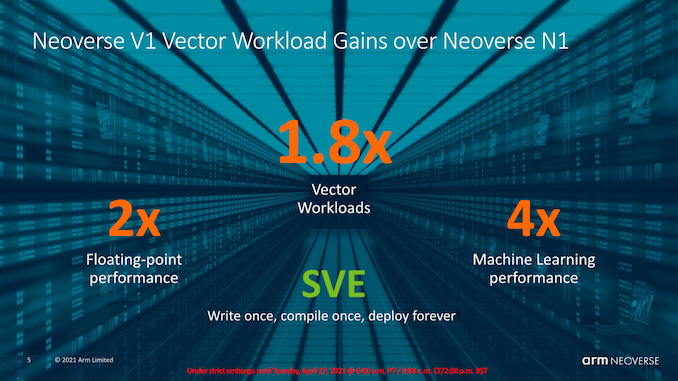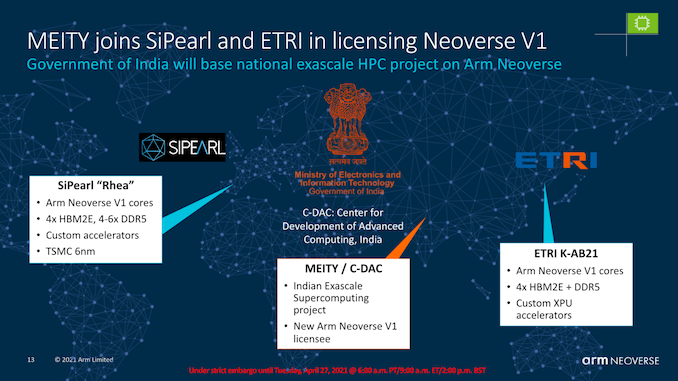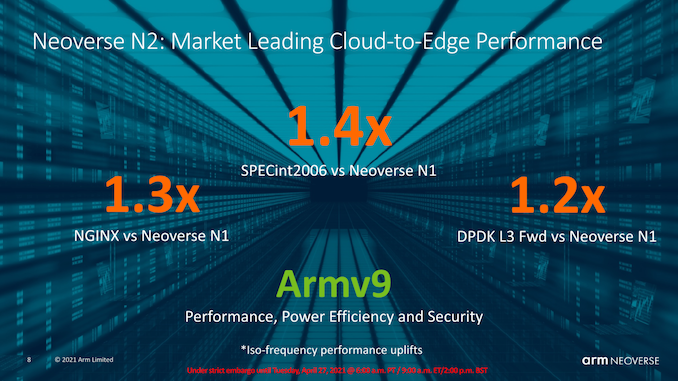Arm Announces Neoverse V1, N2 Platforms & CPUs, CMN-700 Mesh: More Performance, More Cores, More Flexibility
by Andrei Frumusanu on April 27, 2021 9:00 AM EST- Posted in
- CPUs
- Arm
- Servers
- Infrastructure
- Neoverse N1
- Neoverse V1
- Neoverse N2
- CMN-700
First Thoughts & End Remarks
2020 was indeed a super-exciting year for Arm’s server ambitions, and one can easily claims that then Neoverse N1 has been a resounding success and implementations can be seen as being on the same playing field as the best that AMD and Intel are able to achieve, even against today’s newest generations.
The new Neoverse V1 and N2 continue the story in a 2-prong approach. For the Neoverse V1, back when the design was initially teased back in September, I was quite amazed at the claim of +50% IPC. After today’s figures, while the design is still very impressive, the disclosures of the power, area, and resulting power efficiency requirements have somewhat dulled my expectation of the new CPU microarchitecture.
What’s clear about the Neoverse V1 is that this seems to really be an HPC-oriented design. Alongside the known SiPearl Rhea chip, backed by the European Processor Initiative’s goals for HPC uses, Korea’s ETRI (Electronics and Telecommunications Research Institute) also has a V1 designed dubbed “K-AB21” in the works, also with hybrid HBM2E and DDR5 memory. Along with today’s announcement of the V1, India’s Center for Development of Advanced Computing has also announced that they’re a V1 licensee and be using it in an exascale supercomputer project.
Essentially, it seems the V1 will serve as the foundation of many new custom HPC projects, which is a great win both for Arm as an IP vendor, as well as their licensees which are able to build something to their exact needs.
For enterprise and cloud usages, given the CPU’s power efficiency, I now doubt that we’ll somehow see implementations from cloud or merchant silicon vendors such as Amazon or Ampere, particularly because the N2 will be available.
The Neoverse N2 is a more straightforward migration from the N1. IPC is improved by significant amounts which should result in good generational performance increases. I have concerns about power efficiency as the performance increases come at a linear cost of increased power. There’s a one-time opportunity to increase performance in many workloads by closing the power-gap for workloads which do not fully fill the TDP of a system today (while throttling others), however any further performance increases beyond that are dependent on actual good physical implementations by the vendors to fully take advantage of the next-generation process nodes and to execute on those theoretical gains. We’ll see how that will pan out – for now I’ll give the Arm the benefit of doubt, however we’ll also see similar gains in 5nm designs from the likes of AMD. How the competitive situation will end up in 2022 remains to be seen.
Arm had also made a note that while the N2 is a newer generation IP than the V1, roughly a year apart in design, the company actually expects for N2 products to come out only shortly after V1 products, sometime by end of this year. This further enforces my view that we’ll probably not see much V1 designs outside of the HPC market, and that Amazon and Ampere are likely to follow up with N2 based Gravitons and Altras. I want to be explicit here that none of the usual cloud vendors / CSPs / hyperscalers have yet officially commented on what kind of IP they'll be using in the next-generation designs.
The star of the show today was I think the CMN-700, and the vast new flexibility it allows vendors to achieve. The new architectural improvements and the move towards CCIX 2.0 and CXL are definitive big advances that will allow licensees to create more exotic designs. At the very least, it allows for effective usage of chiplet architecture designs, which is a much-needed feature that vendors need to adopt to be able to ensure affordability and manufacturability of products on leading edge nodes.
I’ll be looking forward to new V1 and N2 designs in 2022, and hope we’ll hear more details from licensees through the course of the year.













95 Comments
View All Comments
mode_13h - Thursday, April 29, 2021 - link
Uh...> 2013, they had the A7 (tiny), A15 (small), and A57
> Then ARM made the leap into 64bit processing around 2016.
A57 is a 64-bit core.
> Contrast that to the new x86 competition in AMD
No. Why would we do that? They were competing in totally different markets, at the time. The only partial overlap was embedded Ryzen.
> There hasn't been any upgrades for the "tiny" portfolio, being stuck to ... Cortex A35 CPU
> There has been only a slight refresh to the "small" portfolio, upgrading to the Cortex A55 CPU
The A35 and A55 both launched in 2017.
> they're a joke, and easily surpassable by the competitors.
In terms of what? PPA? Perf/W? Perf/$? Might want to be sure you're comparing apples to apples and not comparing competing "small" core with ARM "tiny".
> There hasn't been any new "large" category for iGPUs from ARM or competitors
Samsung is using RDNA and MediaTek is licensing a Nvidia GPU for its upcoming SoCs.
Might want to do a little more research, before writing another longpost. I agree that A55 could use a refresh, but ARMv9 will force that, anyway. I don't even know where A35 is used, but same story, there.
It's worth noting that ARM has also been active in the microcontroller market, with both 32-bit and 64-bit offerings.
Kangal - Friday, April 30, 2021 - link
Firstly, apologies.I know the A57 is 64bit, but there have been many (most?) implementations of it running in 32bit mode. The A57 was really a "rough draft" for ARM, in moving towards both "medium" sized cores and into 64bit computing. Hence, it feels more at home next to it's A7 and A15 brethren.
The contrast is there, and necessary to show the landscape of the time. The tech industry is a fast-paced one. And if your code/calculations is agnostic, that it can run on any platform, you would consider all options (not that I recommend people go creating agnostic code, compared to specialized or hardware-accelarated code).
The Cortex A35 launched in 2015. It's long due for an upgrade, or replacement. Where this core likes to be in is in small, low-power, and cheap devices. In particular the microcontroller market as you mentioned. ARM hasn't been as active in this field as you think they have, with many of the products being custom designs from the ODMs.
I already mentioned the A55 was a slight refresh for the A53, and that itself is also surpassed. Have a look at Apple's "small" cores. They are Out-of-Order processors, they are slightly faster than an A73, they use slightly less power than an A53. It's mind boggling. Others disagree, and say they're actually faster than A75, and more efficient than A55... but at this scale we're splitting hairs. With that much room for difference, it's not inconceivable (heck it's likely) that an outside competitor like RISC-V will surpass the A55 in terms of Perf/W, Perf/PPA, Perf/$, or a combination of the lot. And remember, the Cortex-A53 is the most popular core out there, where it's getting stamped out on so many different Chinese products.
Samsung isn't using Radeon iGPUs YET, and neither is MediaTek. Besides, we have yet to see them in the wild and find out details if their architecture. These might be licensed from AMD or Nvidia, but they might be "small" iGPUs instead of "large" iGPU designs. I did forget to mention that the Tegra X1, and some Nvidia SBC did actually use their "large" iGPU architecture (ie Maxwell etc).
The gist of my rant is that ARM was a revolutionist early on, basically creating the market. Then they were extremely innovative and competitive, basically dominating the market. Now they are competitive but not as revolutionary nor as competitive/innovative as they used to. With ARMv9 they have a chance to start fresh, and return to status quo, by having a trifecta of products for the computing industry. I was pointing out the gaps in their history and portfolio. They shouldn't just focus on mobile phones, that's boring.
mode_13h - Friday, April 30, 2021 - link
> The Cortex A35 launched in 2015.Okay, the date I saw was wrong. It seems to have been announced in November 2015. The A55 seems to have been announced in May 2017.
> this core likes to be in is in small, low-power, and cheap devices.
> In particular the microcontroller market as you mentioned.
They have actual microcontrollers, though. The A35 is still too power-hungry (and expensive?) for most IoT devices.
> Have a look at Apple's "small" cores.
You focus on performance and efficiency, but what about area? Apple has a narrower focus and different process, cost, & area targets than ARM.
The point we can definitely agree on is that ARM's bottom & middle tier cores should've been refreshed more frequently. But, everyone seems to think that ARM is directly competing with Apple, but it's not. Their objectives meaningfully differ, resulting in ARM probably being driven more towards making smaller cores than Apple.
It's only at the top end of their mobile stacks that you can really say ARM and Apple are in direct competition. However, even on something like the A78, ARM is still put in a position of having to make compromises that Apple isn't.
> ARM was a revolutionist early on, basically creating the market.
> Now they are competitive but not as revolutionary nor as competitive/innovative as they used to.
That's how these things work. A small upstart has a lot of freedom. The bigger a company gets, the more constrained it becomes by its customers, its market, the cost of changing, and the downside risk. I'm still just not totally convinced that entirely explains what we're seeing.
If they can manage to cleave their server cores entirely from their mobile cores, and then really make big cores that are performance-first (instead of scaled up versions of mostly-performance cores, like the X1 and A78 situation), then we might see them start to compete at Apple's level. Basically, to compete they'd have to start by designing the X1 first, and then make the A78 by putting it on a diet.
> They shouldn't just focus on mobile phones, that's boring.
LOL, it's also where most of their revenue still lies. If you were CEO, you wouldn't last a day.
grant3 - Saturday, May 1, 2021 - link
> LOL, it's also where most of their revenue still lies. If you were CEO, you wouldn't last a day.Focusing on the same-ol' same-ol' business is exactly how once-profitable companies fade into irrelevance as technology moves on. Plenty of mediocre CEOs do that.
A great CEO can find the future revenue opportunities and prove it to the company's owners.
mode_13h - Sunday, May 2, 2021 - link
Yeah, but you can't afford to walk away from your bread and butter. Any new growth areas you pursue can't come at the expense of revenues in your core business. If you even threatened to starve your core business, you'd be out of a job before your new ambitions could ever get off the ground.Just look at what happened with Qualcomm, they tried to invest in new areas, but their investors absolutely wouldn't tolerate it. Granted, they're more exposed than ARM would be, either under Soft Bank or Nvidia.
Kangal - Sunday, May 2, 2021 - link
No, grant3 is exactly right.What you said is EXACTLY what Blockbuster said before they went bankrupt. In case you didn't know, the board members passed the opportunity to buy Netflix for $50 Million. The CEO then tried to right that wrong by acquiring another competitor, and shifting their revenue stream. The board fired their CEO, saying that their late-fee revenue was the bread and butter of their business model. Blockbuster was too narrow focused and stuck in the past, that not only did they miss the opportunity of becoming a whole new behemoth, but they sunk their own ship at the same time.
mode_13h - Sunday, May 2, 2021 - link
> What you said is EXACTLY what Blockbuster said before they went bankrupt.If grant3 is saying that Blockbuster should close half its stores while they're still profitable, to divert money into R&D on getting into the (then) almost non-existent streaming market, no company in the world would do that.
Now, it's not like ARM is ignoring other markets, of course. They just can't turn their back on the mobile market, in order to do so.
> Blockbuster was too narrow focused and stuck in the past
The genius of capitalism is that the failure of Blockbuster to transition into a streaming platform didn't keep streaming from happening. Its investors could even get in on the game by shifting their investments into players in the streaming market. If the CEO was such a believer, he could've quit and gone to work for a streaming company or founded his own.
Also, let's not forget that there have already been losers in streaming, and it wasn't clear Netflix would've successfully made the transition from movies-by-mail. Who remembers Google Video? Yahoo even bought some company in the space. And just last year, there was quibbi. I'm sure there are others I'm forgetting.
I think we all want to see ARM succeed outside of mobile. They're been investing a lot, in order to do so. Some in this very thread have been complaining at their lack of focus on their smaller, lower-power cores (currently A35 & A55), which you could see as evidence they've already been making sacrifices to try and compete outside their niche. I don't know if that's accurate, but it's plausible.
If Nvidia's acquisition goes through (as I expect it will), I hope and expect it will provide ARM with the funds to do even more ambitious things.
Spunjji - Friday, April 30, 2021 - link
That's a sound argument for that expectation - it's definitely long since past time for an update.dotjaz - Tuesday, April 27, 2021 - link
Why would you need rumours when we know for a FACT that there will be an A55 successor unless b.L design is abandoned for no good reason. I'll give you a hint, b.L can't have mixed architectures that's why big cores stayed at ARMv8.2a for so long.eastcoast_pete - Tuesday, April 27, 2021 - link
Maybe the shift to ARMv9 will force ARM's hand with giving the LITTLE cores out-of-order designs; however, current bigLITTLE designs already mix big, out-of-order designs with LITTLE in-order cores like the A55. So, bL can and has worked with mixed architectures for quite a while. However, I hope you are correct in that the shift to ARMv9 will force the issue, and we'll finally get out-of-order LITTLE cores also on non-Apple devices